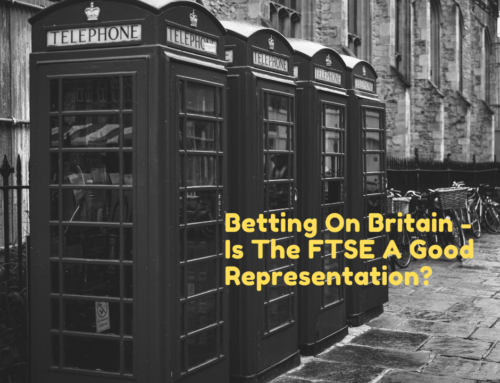Whether you are a supporter of President Trump or not, there is no denying that he certainly has the ability to coin a catchy phrase that can really stick in the public mind.
We have been gifted with many catch phrases and names over the past 12 months: “crooked Hilary”, “drain the swamp” and of course “make America great again”. However, surprisingly the one that has defined the beginning of President Trump’s time in office is the somewhat ironic: “fake news”.
What is particularly surprising about this, is not that the phrase itself has caught on in such a global manner, but that it was such a revelation to many people that sensationalism sells and newspapers are prone to twist the facts to build a story.
In fact, if we are to believe the mainstream narrative, we have been in a period of global deleveraging since the 2007-8 financial crisis, which President Trump is about to drag us out of, with his expected spending.
Further bolstering the idea that we are reaching the tail-end of this decade-long hangover are the recent developments from the US Department of Justice (DoJ). RBS have announced that they’ve set aside a further $3.8bn to deal with litigation by the DoJ regarding their involvement in toxic US residential mortgage-backed securities and the ink is still drying on Deutsche Bank’s own settlement of $7.2bn.
Unfortunately, the hope that the financial crisis and subsequent period of deleveraging will soon be a distant memory of a tough lesson learnt the hard way, is wishful thinking. In fact, a quick analysis of the facts not only shows that the financial industry clearly has a short memory, but also that this supposed period of deleveraging is nothing but “fake news”.
The “Deleveraging” Myth
The term ‘deleveraging’ refers to the action of decreasing financial debt levels by attempting to pay off current obligations being held on the balance sheet. The global popularity of the term grew in the aftermath of 2008, as policy makers focused on re-establishing some form of stability in the global economy.
However, nearly a decade since this process began, current figures suggest these actions were potentially nothing more than a charade. Two major institutions in particular, the McKinsey Global Institute (MGI) and International Center for Monetary and Banking Studies (ICMB), have produced reports that provide tangible evidence, which bring into question the state of global deleveraging and suggest critical reconsideration may be in order.
In the 2015 paper, “Debt and (Not Much) Deleveraging”, MGI studies the changes in debt and deleveraging in 22 advanced economies and 25 developing economies. The troubling conclusion clearly shows that all major types of outstanding global debt are increasing (see chart below).

Chart 1
This outcome provides further incredulity when you consider the low interest rates and accommodative monetary policies enforced by banks worldwide. These advantages were not seized upon to perform the process of deleveraging that we were led to believe would be undertaken.
The ICBM economists in their report on this topic reached a similar conclusion. Their analysis of national accounts data resulted in the worrying finding that global debt has actually been rising even as a percentage of global GDP, since the 2008 financial crisis (see chart below).

Chart 2
The “The Real Estate Reality” Myth
Given the data in the above charts, the statistic that stands out as most concerning is the substantial growth in US household debt.
When we further break this category down, we find that the latest statistics regarding mortgages are particularly distressing. One may even suggest that the country is creeping back towards the same conditions, which triggered the bursting of the real estate bubble in 2008.
The following series of data paints a picture for real estate that is certainly not rosy:

Chart 3
The median sales price for new homes (chart above) has been rising strongly since 2012 and is now evidently at a level much higher than that observed prior to the 2008 crisis.
This price increase is also represented in the Case-Shiller index (chart below – adjusted for inflation) which shows a clear, steady increase since 2012.

Chart 4
While the prices are rising, real estate sales activity is also increasing (chart below). This suggests there is potentially an increased interest in speculative home trading.

Chart 5
While the data shown thus far may depict a sector that is growing and thriving, once you offset it against other metrics, the reality of the disequilibrium become more apparent.
In addition to the rising house prices, we are also seeing a sharp increase in the long-term, fixed mortgage rate (chart below). The sub-prime rate has also been rising, as can be observed in the Zillow Mortgage Rates (not shown).

Chart 6
These combined factors lead to the obvious outcome of US affordability declining (chart below).

Chart 7
In isolation, this series of data does not appear too concerning. If real estate is growing and thriving, prices will rise. Unfortunately as a result of that, affordability will inevitably reduce. However, when we observe what real effect this is having, we begin to understand the dire situation that is potentially being created.
As witnessed in the build up to the financial crisis, foreclosure activity has started to climb (chart below). The increase of 27% represents the largest percentage increase since 2007.

Chart 8
The “Heedless Activity of an Industry with a Short Memory” Myth
With the regulatory environment experiencing significant change since 2008, the legal risks associated with mortgage activity have increased. As mentioned previously, there have been a number of big cases, even as recently as January 2017, of financial institutions receiving large fines for unsustainable mortgage business.
As a result of this, traditional banks have begun to move away from low deposit and low credit lending. However, this by no means excuses them from being involved in risky practises related to mortgages. As recently as 2015, Goldman Sachs launched its so-called Bespoke Tranche Opportunities, along with other banks, which appears to simply be a new name for a customised version of a CDO (collateralised debt obligation). In the hunt for yield, banks are willing to operate with a short memory of previous mistakes.
Non-bank players have started to mop up the riskier loan business instead, as shown by the current share of low down payment loans (chart below).

Chart 9
As a result of this, the non-bank share of mortgage originations has been steadily ascending since 2009 (chart below). Non-bank entities must comply with the same regulations as banks when it comes to lending. However, there is gulf in ability to withstand difficult financial times, as they have far less access to resources than the traditional banks do. For example, they are not allowed to tap emergency funds through the Federal Reserve and the Federal Deposit Insurance Corp does not protect their deposits.

Chart 10
This means, if delinquency rates rise to the point of which there is an issue with liquidity for one of these institutions, they will be forced to request short-term financing from the traditional banks.
A study by the Mossavar-Rahmani Center for Business and Government explains some of the key concerns about non-banks and the counterparty risk they represent if a real estate downturn once again emerged.
One area of alarm is the reliance on Federal Housing Agency (FHA) insured loans, which are 100% protected by the Federal Government. Since FHA loans are more affordable to first time and subprime borrowers due to the low deposit requirements, this increases the potential severity of a housing market downturn.
Approximately two thirds of all FHA lending is originated by non-banks. Surprisingly, the FHA mortgage insurance premiums are not linked to the credit score of borrowers. This is a situation that has the potential to eventually be exposed as unsustainable, considering half of the loans originated by non-banks are to borrowers with FICO scores below 660 (otherwise known as ‘non-prime’).
The “Should We Prepare for Round Two?” Myth
Although the data and overall picture we have outlined is certainly concerning, it does not necessarily represent imminent danger. As mentioned in the final section, the tightening of financial regulations has gone some way to helping provide more stability in lending products. However, the need for deleveraging and the issue of disequilibrium persists.
While the financial world may dismissively move from one key concern to the next and have a short memory of past issues that appear to have been dealt with, we do not necessarily need to fall under the same ruse. While the immediate focus may be on so-called ‘bigger picture’ issues like President Trump and his spending to “Make America Great Again”, one should be keeping a close eye on the growing issue of consumer credit and scrutinising any negative shifts in key metrics, such as those outlined above.
While debt continues to increase since the financial crisis, the ability to deal any reoccurrences of similar problems will be severely hampered by the distinct failure thus far to not only reverse the situation, but at the very least, to ‘keep our powder dry’.
By Nicholas Puri & Lorenzo Beriozza


